A vision for climate action by Justin Winters of One Earth at Techonomy 2024
In a compelling presentation at Techonomy Climate | Encoding Resilience, Justin Winters, Co-founder and Executive Director of One Earth, highlighted the critical role of integrating nature into our strategies to solve the climate crisis and biodiversity loss.
One Earth has developed a Solutions Framework based on the groundbreaking One Earth Climate Model. Developed in collaboration with over 50 leading scientists, the model shows that limiting global warming to 1.5 degrees Celsius using existing solutions is possible by transitioning to 100% renewable energy, conserving 50% of the world's lands and oceans, and shifting to regenerative agriculture practices.
The discussion extended into the financial implications and the necessity of investing strategically in these solutions. Justin highlighted the troubling lack of funding for nature conservation and regenerative agriculture compared to renewable energy and argues for a balanced allocation of resources that supports all critical climate solution pathways.
Justin emphasized the importance of integrating Indigenous knowledge and practices, which are often overlooked but are vital climate and biodiversity solutions.
Despite the promising strategies outlined by One Earth, Winters acknowledged the ongoing challenges in gaining widespread adoption and understanding of these necessary shifts. She called for a concerted effort to educate and engage various stakeholders, from investors to the general public, in embracing a multifaceted approach to climate solutions.
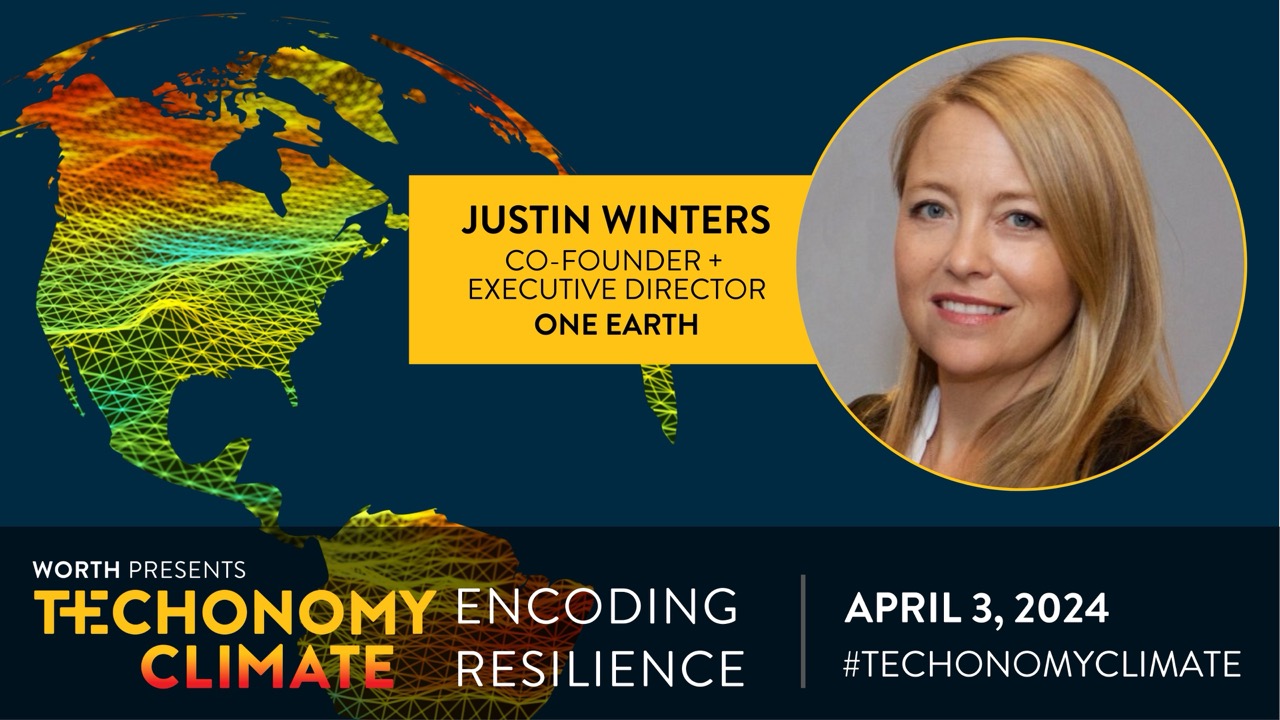
Transcript
Justin, we are in the home stretch. We've heard about AI. We've heard about synthetic biology. We've heard about robots. It's a fantastic time to be alive. So, let's pivot. Why don't you explain to me why you think nature should be the starting point for our roadmap for addressing climate change?
Great question. It is so interesting to follow up on our last conversation on this topic. I'd say we're in a really interesting moment where the challenges that we face are predominantly related to the fact that we've been completely divorced from, separated, and disconnected from nature.
And we're in a moment where there are no silver bullet solutions here. There is not one single technology that's gonna solve all of this. We're in a moment where climate change, biodiversity loss, and how to sustain human life require reconnection to nature and an understanding of the complex systems that create life on our planet.
I mean, think about it. We are not separate from nature. We are nature. We breathe clean air. We drink clean water. We have access to healthy food because of nature.
So this is a moment. Not only that, there is a theme that keeps coming up this year—mental health. People are unhappy. They feel separated. They feel alone. They're lacking community, and they're lacking connection to nature.
So it's time for us to, as exciting as it can be, and it should be, think about all the incredible new technologies that can be invented. And some of that is absolutely necessary at this moment. But, if we do that without protecting, connecting, and restoring nature, changing our energy and our food systems in a way that honors Earth first, we are not gonna have the future that we want.
Do you want a future that is all robots and carbon capture happening? And meanwhile, we've razed all the trees. There's no biodiversity left. All the things that make life on this planet special, inspiring, and invigorating are gone.
We don't want that. So, there is a future that is yet to be written that is potentially a combination of both honoring cultural diversity and biodiversity and embracing the right technologies at the right moment and on the right scale.
So, in order to do that, it seems like one would have to have some kind of framework to structure that investment in that strategy.
Do you have one of those?
Yeah. And I'm going to flip through a couple of these sides first. So, at One Earth, we've had an existential question that we've been seeking to answer since the early days, even before we were our own nonprofit.
The question was, can we actually solve the twin crises of climate change and biodiversity loss? Is it possible?
This started the One Earth project, which was initially a research project but always a research project that was intended to enable and facilitate action at the scale and speed that we need.
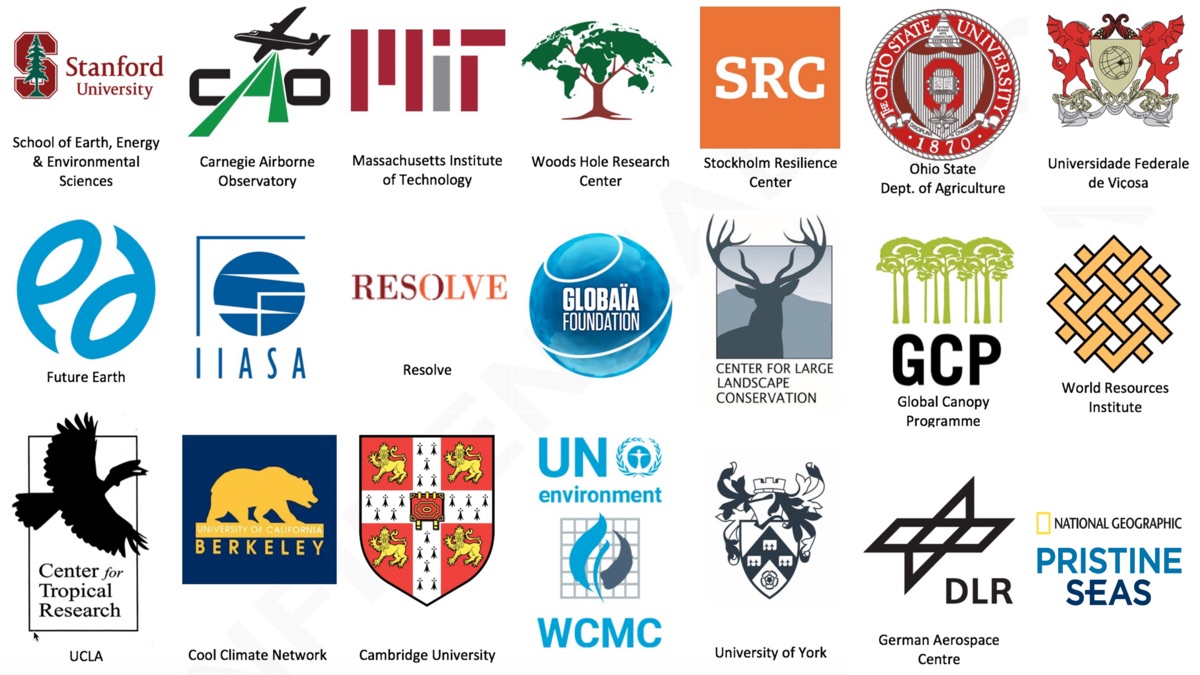
One Earth's Knowledge Partners
We embarked on a crazy quest to get an answer. We worked with over 50 leading scientists and experts, particularly the University of Technology, Sydney, and German Aerospace, and they produced a climate model.
It’s really crazy to think that we went down the rabbit hole of spearheading a climate model. But when we looked under the hood and called all the leading academic institutions and scientists and climate scientists, et cetera, it turned out that a climate model had not been done that proved that it was possible to limit global temperature rise to 1.5 degrees Celcius and to do that with existing solutions.
Why existing solutions? Because that was the lens through which we could include nature in the equation.
So, the first product was the One Earth Climate Model. The short answer to the question 'Can we solve the twin crises of climate change and biodiversity loss?' is...
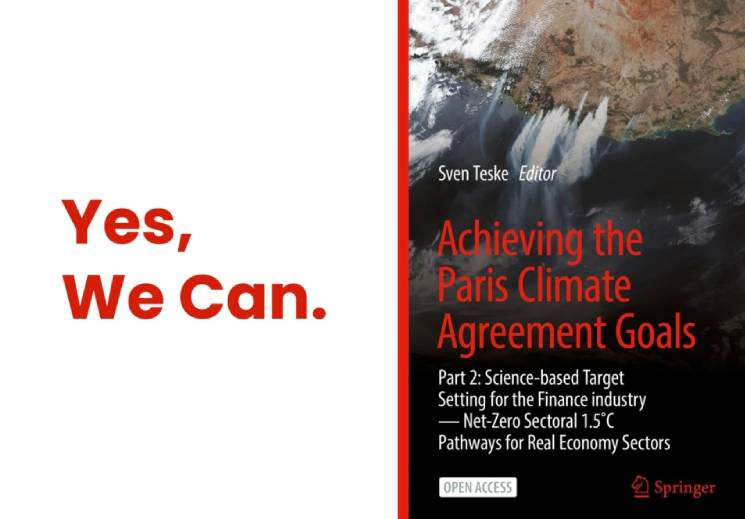
I'm not saying it's gonna be easy, but it is still possible for us to do it, and we can do it with existing solutions.
The One Earth Climate Model was published by Springer Nature. Originally in 2019, updated versions have come out since then. In fact, more recently, just a couple of years ago, the financial sector ended up funding the updated version of this because they were really intrigued by what the science was proving and showing that it could do.
They funded it presumably because they understood that there were huge financial consequences to how this model was being built.
Yeah, I mean, I think that this climate model was ahead of its time, and I think it took a little bit of time for it to kind of make the rounds and for people to understand what it was saying.
And we certainly went deep in unpacking this 500-page book and understanding what it had to tell us. And top line, what it had to tell us was that there are three core solutions pathways to solving the climate crisis.
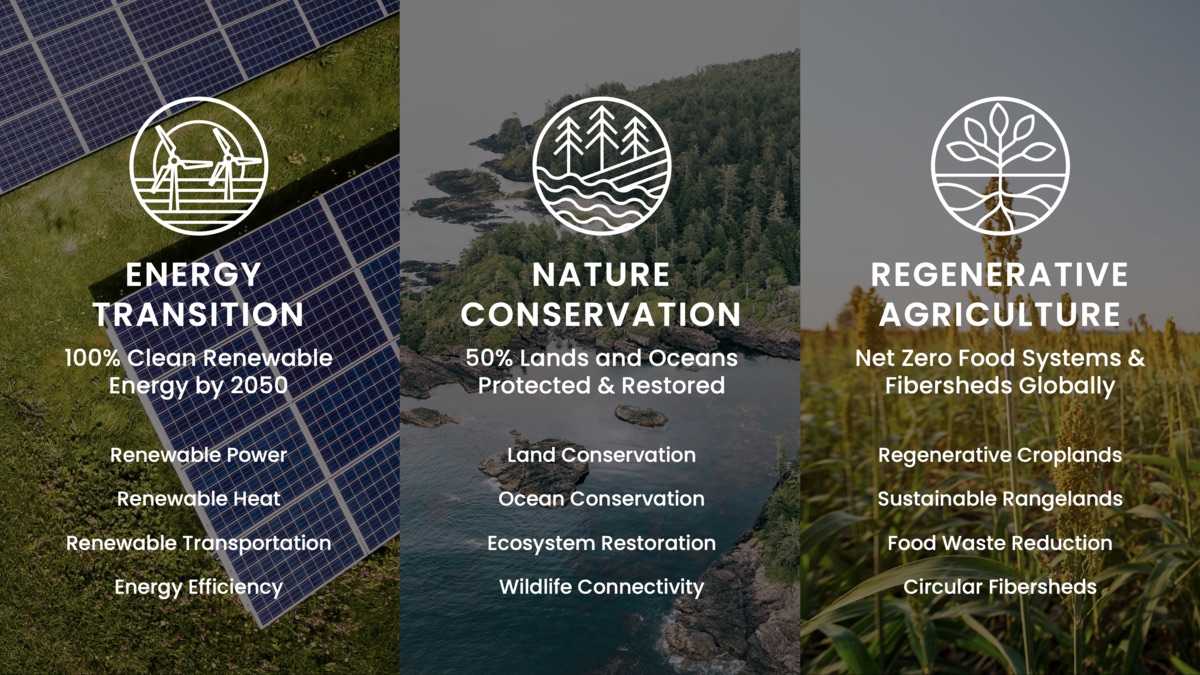
One Earth's three pillars of collective action to solve the climate crisis.
- First, we have to transition to 100% clean, renewable energy, which is obvious to everybody in this room.
- The second piece is that we need to protect, connect, and restore 50% of the world's lands and oceans. Not just 30, 30 is a really critical stepping stone. The ultimate goal is 50%, and that is a global goal. It's different in every region, every country, and every state, and each has a different roadmap of nature that needs to be protected and restored.
- The third pillar is shifting our food and our fiber systems to regenerative agriculture.
This gave birth over a couple of years of analysis and working again with our networks of scientists and experts to the One Earth Climate Solutions Framework. And don't worry; you can access all of this on our website. We very much believe in getting this knowledge and making it accessible to everybody.
.jpg)
One Earth Climate Solutions Framework
But essentially what you're seeing on this slide is those three core solutions pillars. Then, each of them breaks down the specific solutions that reside within renewable energy, nature conservation, and regenerative agriculture.
I call it the ‘WHAT.’ This is what we need to invest in, what we need to support and scale. And this is prioritized by a global climate model. There is some very deep, credible science to back this up.
At the bottom, we ended up adding intersectional themes and levers of change, which ended up being a really interesting addition to the Solutions Framework.
I call it the ‘HOW,’ how are we gonna get there?
People who are incredibly smart and experienced but are so focused on one particular area of work or one solution set start to forget about the many different levers of change that we have.
Of course, we are not gonna simply drive global transformation through an international policy framework.
That is one mechanism for driving change. There are all of these other things that need to be deployed at the same time—climate finance, philanthropy, community action, legal empowerment, education & awareness.
So this really represents, in an architectural framework, a solution set that is backed by science and accessible, and it also represents the complexity and the diversity of solutions and methodologies that we need to deploy right now.
So this is an amazing work, it's voluminous. There are, I mean, you can see how many different rabbit holes are to fall down there. But so what are the examples of it actually being put into action in investments being made, policies being changed? Do you have anything you can share?
Sure, you know, I'd say it's early days. We had no idea when we started this what we were unraveling.
We've spent the last couple of years not only doing the hard work of assessing and building the science but also breaking it down into educationally accessible material for everybody.
But also talking to people, presenting it, sharing it, and getting feedback. And I'm pretty blown away by the lack of knowledge about what this moment requires.
Among who?
Everyone. Whether it's investors, philanthropists, activists, you know, everyday citizens, decision-makers, or government leaders, climate change is complicated. And because we are so deeply divorced and disconnected from nature, and, you know, there are people that really genuinely don't understand where their food comes from.
We're so far apart from a baseline understanding of this Earth and how it supports life that we're in a moment where this is an opportunity to kind of re-educate ourselves about what this moment requires of us.
So, not to say that we haven't figured out we're not developing ways in which to deploy this and move it into action. I'll speak about kind of the finance piece of it in a little bit.

One Earth's Executive Director, Justin Winters, speaking at Techonomy Climate | Encoding Resilience. Image credit: Courtesy of Worth.
We're very committed to making this accessible to everybody. So we create really generous, robust content that defines all these different solution sets in video content and also in written form. We are partnering with different types of partners who want to apply this framework. So, we have initial conversations with investors who are wondering how we can adopt this framework as part of our investment staff strategy.
So, these are early conversations.
Same thing with philanthropists. They want to know how they can use this strategy to influence their philanthropy and make it more strategic. How can I deploy dollars and capital more strategically?
More recently, we actually partnered with a fellowship program that wanted us to assess fellows that we're applying for, and these were, you know, new startups, leaders of new startups. They wanted us to help them assess their group of fellows that had applied according to our solutions framework. And you know what the leading kind of takeaway from that effort was?
Do tell.
How many brilliant, amazing, incredibly talented people were starting companies and technologies that aren't really what our planet needs right now? That are the opposite of what the planet needs right now?
Really?
Yeah, and I think that's because there are so many people that are well-intentioned at this moment. They want to be part of driving change; They want to apply solutions. They want to give their time and their talent to be part of this.
Climate tech is the buzzword. We're all gonna jump in and make tons of money and save the planet at the same time.
Or, you know, I want to legitimately apply my talents to this. But it requires us to take a moment to step back and understand what the planet needs and how we can facilitate the regeneration and healing of our climate. And that needs to be strategically thought through. We have a very limited window of time.
Can I get you to throw any particular businesses under the bus?
No. These are all new startups. Interestingly, we had a chance to attend an educational seminar with them. And they were pretty blown away. And I think empowering folks like that, who are excited about putting their time, talent, and energy into climate change, and educating them so that they can put their energies towards a strategic solution set that is really needed and necessary, is a huge opportunity ahead.
So it's really early days for us and kind of figuring out how we're gonna apply this.
Yeah, it's actually something Worth has been covering a lot.
It's like the inefficiencies in philanthropy. The same thing happens with startups. And that they're just because it may not be a good idea. It may not be the most efficient use of money.
And I think the same thing happens in the climate tech space, where it may seem like a good idea. But again, if you think through all the consequences, there are better ways to solve the problem.
A lot of the fellows that we ended up assessing were coming up with really interesting, seemingly sexy climate tech solutions or technologies and not thinking through the repercussions of that technology.
What would the long-term impact be on the ocean where they were deploying the technology? We cannot continue to kind of operate through the singular humans know best; we're the brightest and the smartest, and technology is going to get us out of this problem.
We really have to think much more holistically in the long term, and we've got to put our egos in check.
Yeah, and I think this framework is exactly that, where you're trying to, I haven't used the phrase all day, boil the ocean and try and summarize it all in one slide. But I mean, it comes very close and it's certainly well thought through.

The Global Safety Net—another large-scale piece of scientific research that we spearheaded, again in partnership with networks of scientists, academic institutions, and on-the-ground experts—was an effort to map not only how much land we need to protect, restore, and connect but where.
The initial mapping effort is an amalgamation of several central critical pieces, layers of information, and mapping around the world. Initially, that paper came out in 2020. And that's the paper that identified that we needed to protect 50% by 2050. And that 30% was a really critical stepping stone to reaching 50.
We ended up partnering with Google Earth Engine and making that science geospatial and accessible to everybody. So you can go on globalsafetynet.app to not only access the science but also explore the interactive viewer, which allows you to go around the world and see the roadmap of nature on land that needs to be protected and restored.
That science has had a really profound effect on international policy goals around conservation.
We have users from 195 different countries using this as a roadmap for how they're going to implement the 30x30 goals that Julie mentioned earlier today. We have bigger plans for what we'd like to do, how we'd like to scale this platform, and the science in the next couple of years.
Can you share some examples of places in the world that people may not think about needing to be protected and that could very easily be lost if they aren't protected, that this map is sort of uncovered and revealed?
Yeah, and actually, in June, we'll be launching an upgrade to the app that includes a new piece of science called Conservation Imperatives. It's peer-reviewed science that will hopefully be published in May, we think, that identifies the last remaining refuges of nature on land that house really deep biodiversity, endemic species, and carbon stores. Many of these natural areas with incredible biodiversity around the world also have very deep carbon stores.
We literally cannot afford to lose them for two reasons. We don't want to risk losing biodiversity and those essential carbon stores. These are also the refuges of nature that are also producing clean air and clean water, making for a stable climate. They are really a central part of the equation.
And again, I think the beautiful thing about it is the global solution. We are very US-centric, and we don't think about the fact that all these natural preserves or all these natural resources across the globe are really benefiting all of us.
The problem with resource extraction is that nature is not priced properly. This doesn't put a price on it per se, but it at least shows where the value is. And eventually, we could put a price on it.
So, this is obviously a room full of people who are involved and care about these issues. Is there anything they can do to participate other than reading the material and educating themselves about the nature of these relationships? How can they participate?
We have a project underway right now with Vibrant Data Labs. Eric Burlow is here with us today in the audience. He is a data scientist who's using machine learning to really assess where resources are flowing and where they're not flowing.
He created something called the Climate Finance Tracker. We are partnering with him and overlapping the Climate Solutions Framework that One Earth has created, combining it with Eric's approach to assessing data and resource flow.
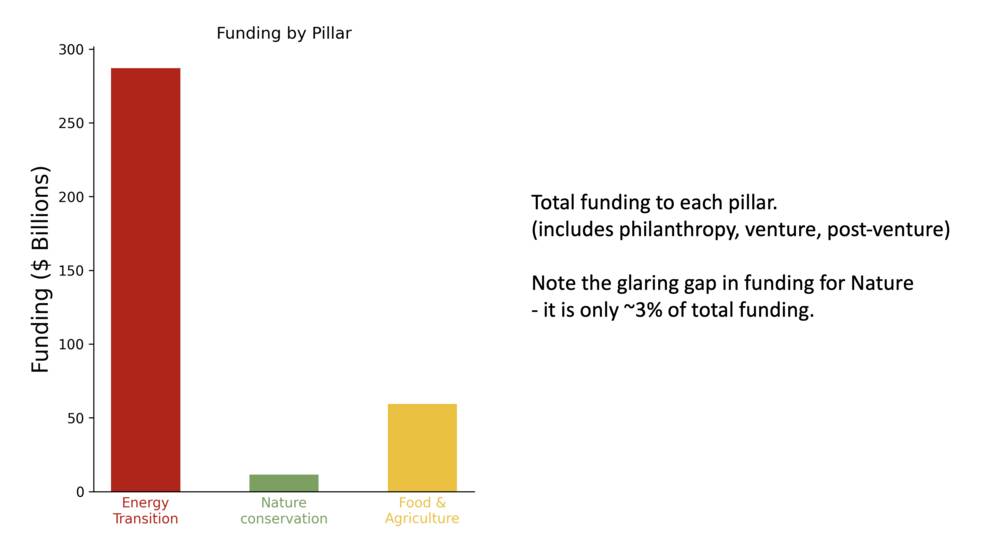
So what you're seeing on the screen are the very initial findings that he has illuminated for us. This shows you, according to the three pillars of One Earth, and we have much more detailed data and information in the works, but the very top line that shows you how much money is going into the energy transition, which is great.
But it's also showing you just how little capital is flowing into nature conservation and regenerative agriculture. I mean, it is astounding when you look at that.
I mean, look at the green. That is Earth. That is the very thing that sustains life. And it is getting absolutely no resources for protection, for restoration, for creating connectivity.
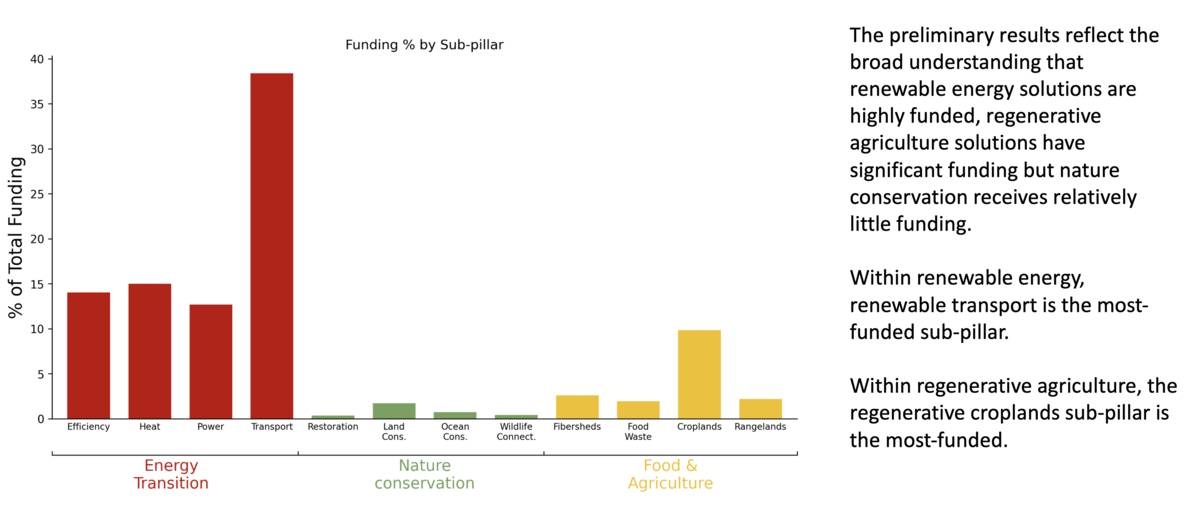
It is astounding, actually. And so we hope that these kinds of projects that we're taking on help to illuminate where resource flow needs to be heading and how to prioritize climate finance and philanthropy. It could really change the game and also elevate how little resources equitable solutions are getting.
Got it. So, I want to open it up to the audience. We're going to go from a Q&A, from your session to the overall town hall, probably pretty seamlessly, but let's start with some questions for Justin. Right here up front.
My first exposure to the kind of things you're doing was through Paul Hawkins's drawdown project. And I would imagine that a lot of that fed into your model and what you've been talking about here. Would you talk a little bit about that connection?
Paul was one of the people in my life that inspired me to do this work. I met him through the Bioneers Conference, which actually just happened. But many years ago, back in 2007, and, you know, Paul's incredible understanding of the inner connectivity of life is truly inspired by this work. When I was running a foundation in my life before doing One Earth, we ended up funding some of the initial work for Drawdown. So there's overlap.
There are multiple frameworks out there right now. What makes One Earth's framework special is the fact that it's based on a global climate model. No other current frameworks are. And because we incorporated the role of nature in solving this conundrum, it elevates equitable solutions. So, it's a unique framework that I think really needs much more exposure.
So, it sounds like you're introducing a new model because things are inappropriate for you. And resources are not appropriate to reality. There are existing models that people have thought they've been following. The SDGs. Like, just hold it a little closer. Like the SDGs and various regulations, whatever. So, is your model complementary to those? Or if you met a philanthropist and they said, "well, I thought I was doing the right thing. I've been following these models, and now you're saying I've missed my focus". I mean, how do you handle that?
Great question. It’s one that we have grappled with because we didn't know exactly what we were going to land on. I guess my answer to that is, I mean, the ESG served a very important critical purpose and was one of the first attempts to really show interconnectivity between different issues.
Because this is based on a global climate model and additional streams of science that have been done, it suddenly creates a lot of clarity through the lens of climate and the urgency of climate around what we need to do now and what the priorities should be. So, I see it as additive.
I would never want to take down the SDGs. You wouldn't want there to be a model competition that we put on TV to declare America's top model? That would be interesting. But no.
You know, looking at this graph, of course it's the question-wise, is there such a big difference? And you would say immediately, well, on the energy side, it's pretty clear because that essentially determines the standard of living on Earth. And it is completely financially documented extremely well. I remember in the 2000s when the whole questions on nature came up, there were sort of various efforts of, you know, go plant trees to make up for the miles that you had been flying somewhere and so on.
And they came pretty rapidly in disrepute because there was no financial model that either held water or that actually was controllable in light of other economic interests, let's say, in the Amazonas to just take n acres and bulldoze them. And so I wonder in this very interesting perspective, if there's a way for your organization to find an economic connection, even if that connection may have a longer time frame than the rapid reduction of CO2 because biodiversity takes a longer time frame. But without that, you're in a, well, it's apples and oranges, and you cannot trade them. And I think you're seeking to get the green a little up here. Is there any effort in that direction to create hope?
I mean, it's such a great question. And there are a lot of early-stage conversations happening across the movement at large, I would say, around the concept of biodiversity credits. And people are really grappling with this.
What is the right way to do this, and how do you avoid some of the pitfalls of carbon credits? Which in many cases was incredibly problematic, especially for local communities and Indigenous communities. So I'd say we are very much involved in early conversations about that, learning from others, partnering with economists, etc.
There isn't a perfect solution yet. You know, we're kind of keeping a price of it, weighing in when it makes sense. One thing to consider when you're looking at these three pillars and noticing how small nature conservation is is that it also begs the question, how can strategic deployment of different types of capital help to level this up a bit?
So, for example, philanthropy can and already does, but it needs to be radically scaled around nature conservation and regenerative agriculture. Less than 2% of all philanthropic capital goes to climate and environment. I mean, that is absolutely insane at this moment.
Philanthropy could be playing a radical role in helping us solve this, but people really have to embrace it as a leading strategy. So, it is an imperfect path forward, but I think having illuminating scientific data, knowing what the planet needs, knowing what it means in a geospatial context—what country, what regions.
We've got to be really smart in this moment, and I think that we can challenge everybody to think about how they deploy their capital and their types of capital in a different, more strategic way.
What would you say, and again, your focus is on nature, not climate tech, but is there anything in the climate tech space, anything you heard today that you're like, that actually could have some legs and could scale and could do some good?
It's interesting, as we kind of came out with the solutions framework and were challenged with questions like this, and throughout thoughtful discussions with partners, I kept wondering, how do I answer this climate technology conversation?
But the truth is that with all of the solutions within the solutions framework, there are infinite technology opportunities across those solutions. You know, whether it's energy efficiency or scaling geothermal, or there's technology has a massive role to play across many of those solution sets.
And even just to give an interesting one, you know, from a conservation lens, supporting Indigenous-led community-led conservation efforts across the board, across the world, is a critical solutions pathway.
I have seen some amazing technologies that have been developed in partnership with Indigenous communities and deployed with Indigenous communities for mapping their lands and supporting Indigenous land tenure rights.
Digital Democracy has done some phenomenal work building technology from the ground up in partnership with Indigenous communities to support their Indigenous land tenure efforts. What came out of that is not only brilliant but really astounding: it shows how different things can look when they're led from a different cultural perspective.
Yeah, in the agricultural space, too. Just up and down, there are tremendous innovations. And I think maybe I don't want to critique the program; we're still in the middle of the program, but when we do this again in New York and September, I may lean into the agricultural space a little more heavily, just because there's so much work being done there. And again, it's a huge part of the problem, and it can be part of the solution as well.
There was an interesting thing that happened during one of the breaks I spoke to the conference convener outside and said I was interested in the amount of AI that didn't include Indigenous knowledge because the oldest form of knowledge that we have is their relationship with nature. And there was another chap standing next to us and said, but surely that's just anecdotal; that's not data.
So, what I've noticed in your models there as well is that there is a great deal of information that sits amongst Indigenous people. And I don't think it's necessarily non-Indigenous that the barrier to that being flowing into models like this. But have you found some opportunities that you can tell us about where those barriers can be broken down more easily?
Because when I sit in the room here, I only found one person today that looked like me, that had a brown face, and then I found another one, and that's a difficult place to come into. And I would have thought that your talk would have been first today. Is the question, do you want to be first, or do you want to be last?
I didn't have a chance to kind of expressively share this, but we work with networks not only of scientists and experts but also on-the-ground knowledge holders. They have provided input into all of the models that we've developed. And we have much more to do.
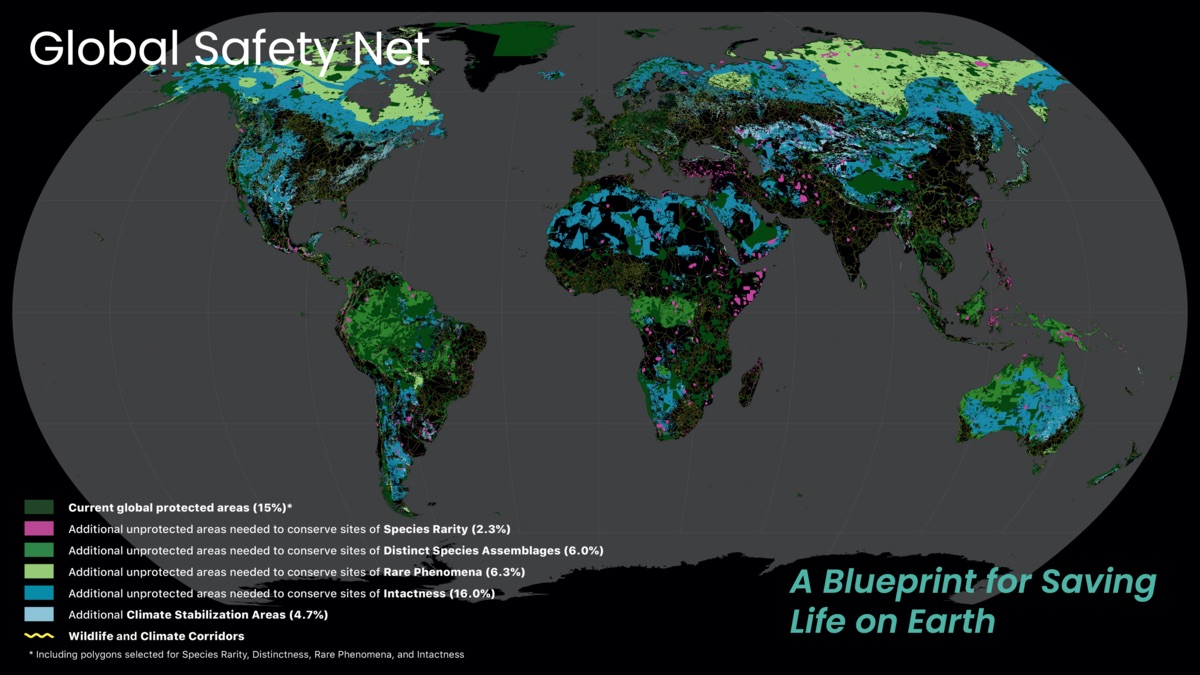
Interestingly, at least one-third of the lands that we illuminated in the Global Safety Net are Indigenous lands. Therefore, achieving the 50% goal for nature is literally not possible without elevating and, in fact, supporting 100% Indigenous land tenure. One hundred percent.
There's so much knowledge that is needed out there and understanding that we need to revert back to very Indigenous, very old Indigenous knowledge carriers.
And we need to connect. We need to build community with different, different races, different cultures. We need to embrace all of these systems. It's been a process with One Earth and building this out.
Ultimately, what I seek to support is a vision of the future that embraces not only biological diversity but also cultural diversity. And how the two are part and parcel of the same coin. And that's certainly a world that I want to fight for.
With all the headlines now, how can we stay inspired?
So, part of the reason that we built this out is that I had the honor and the privilege of building a foundation. I ran the Leonardo DiCaprio Foundation for 13 years and built it from the ground up. We raised and deployed over $100 million to 200 projects around the world—most of them community-led, grassroots-led, and/or Indigenous-led.
The privilege of being in conversation and partnership with millions; I didn't have millions, but this vast network of changemakers that are implementing the solutions and that are illuminated on that climate solutions framework around the world injected me with a permanent sense of optimism about what's possible.
So, a lot of the work that we do at One Earth is to hold up and elevate what we think is a central solution at this moment. And that is bottom-up, grassroots, community-led solutions. On our website and across all of our media channels, we're in partnership with hundreds of local nonprofits and local communities.
We help elevate the stories of the solutions that they're implementing and the knowledge that they're holding. We do that because everybody deserves to tap into the movement of people who are doing the work, and they need the resources and support to scale their work.
When you tap into that, you know what's possible. It is not game over. It is not. We just need to move quickly to support the people doing the work on the ground.Learn more about our work
You might also like
-
%20(2).jpg?auto=compress%2Cformat&h=600&w=600)
Justin Winters: Collective Action for the Earth | The Time of the Feminine Podcast
One Earth's Executive Director, Justin Winters, discusses why collective action is the solution to solving the climate crisis with Shaina Conners from the Global Sisterhood on the Time of the Feminine Podcast.
-
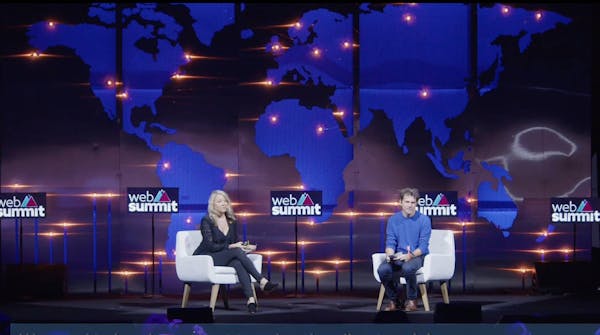
Justin Winters presents the One Earth Project Marketplace at Web Summit, 2022
During the Planet Tech conference on the last day of Web Summit 2022, One Earth's Executive Director Justin Winters was joined by The Guardian's Oliver Balch in a session titled, 'We need to inspire and act to solve the climate crisis'.

